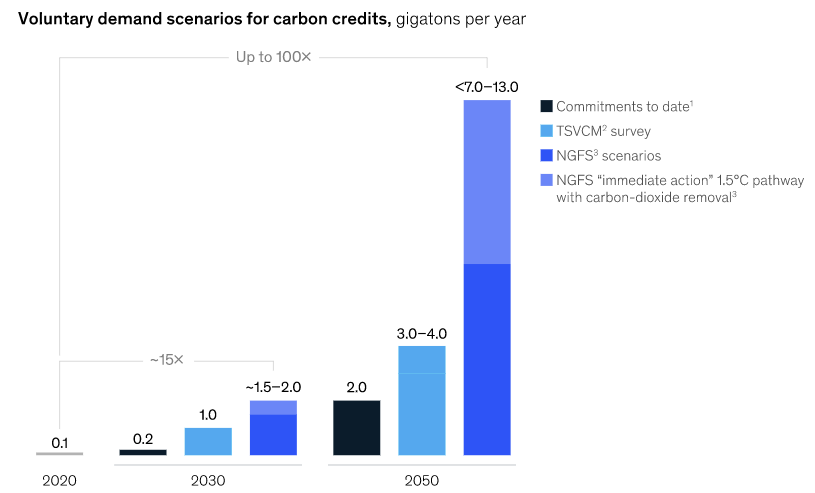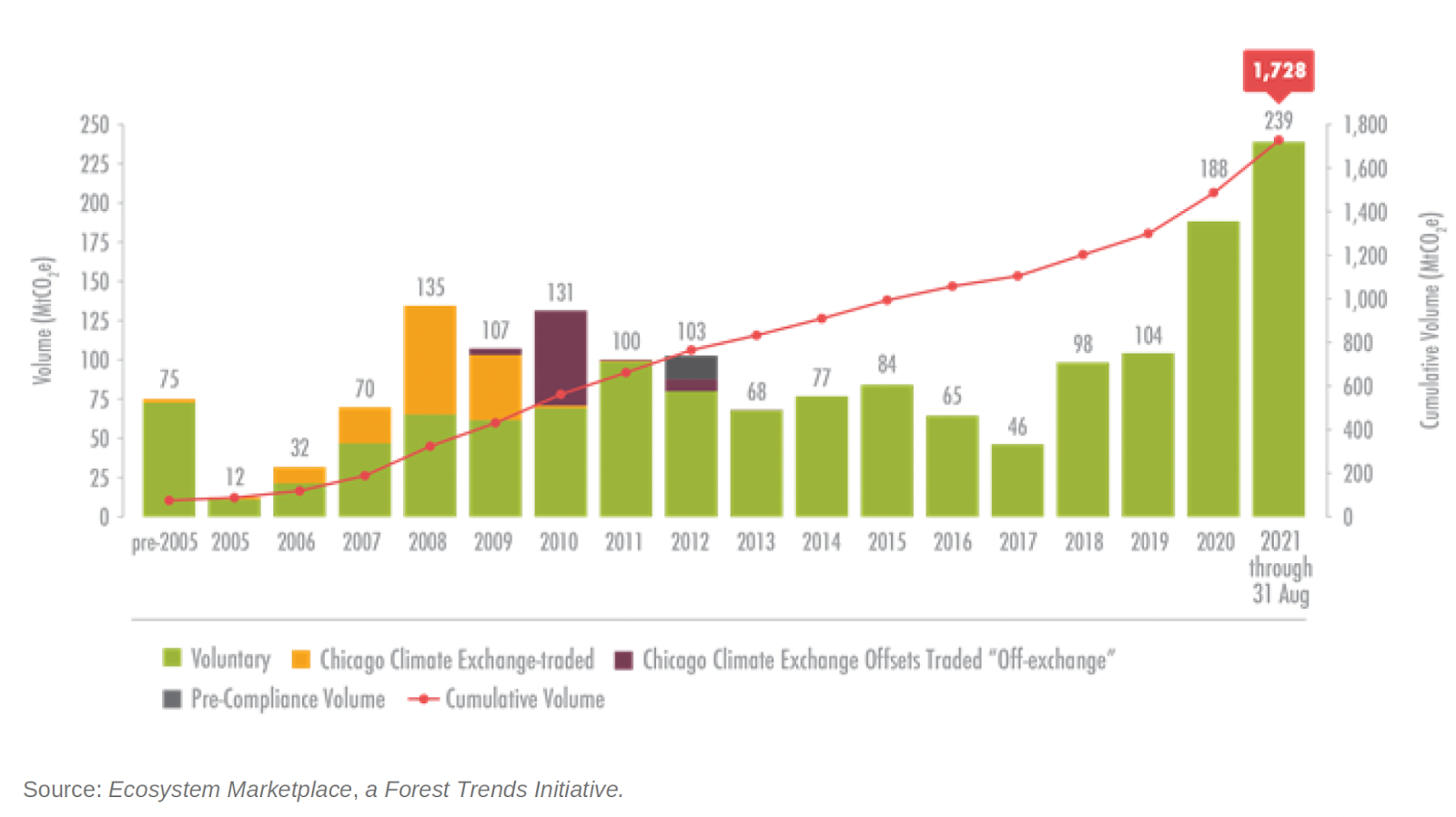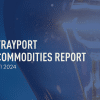The market for voluntary carbon offset credits is by no means new, having been around for at least the last 20 years. What is new is the tremendous interest that it has generated over the last 12 to 18 months, allowing it to emerge from a small niche market to one that is well on its way to becoming mainstream.
A recent report from Ecosystem Marketplace has indicated that transactions in the voluntary market may exceed $USD 1bn for the first time in 2021. While this figure is relatively small, it would represent a doubling in transactions year-over-year. Perhaps more telling are growth projections; McKinsey, the strategy consultancy, released a forecast predicting a potential 15x increase in market size by 2030, with a corresponding value of over $50bn.
Market forecasts aside, what is clear is that carbon offsets are going to play an important role in helping companies meet near-term net-zero commitments and will be a key enabler in a more economic transition to a low-carbon economy. This article introduces readers to the voluntary carbon market, drivers of growth, risks and opportunities and, finally, market developments that will help facilitate this growth.
What Are Carbon Offsets?
Carbon offsets result from projects that either reduce greenhouse gasses (GHG) entering the atmosphere (e.g. energy efficiency), or projects that remove GHG from the atmosphere (e.g. improved forest management). Voluntary carbon offsets, as the name suggests, are not part of a regulatory or compliance program. They are, however, developed within the framework of a voluntary standard (e.g. Gold Standard, Climate Action Reserve, etc.) which prescribe processes and methodologies through which offsets can be created, ultimately verifying and serializing offsets on a registry. As such, they can be thought of as ‘verified offsets’.
Voluntary carbon offsets and markets do not share a unified standard; there are, instead, a number of well-established offset standards through which offset projects are developed. Within each standard there are also a variety of different offset types which can align with different attributes or co-benefits, that may align with an entity’s corporate values or broader ESG initiatives. For example, a forestry project represents a GHG removal type of offset project, while also providing ecosystem benefits (e.g. habitat).
Voluntary carbon markets can be accessed through trading platforms, brokers, or directly with offset project developers. Once serialized and on a registry, voluntary offsets may be bought and sold by different parties, with ownership changing hands on the respective registries. Buyers may also choose to have offsets retired on their behalf.
What Is Driving Growth In The Voluntary Carbon Market?
Fundamentally, growth in the VCM market is driven by growing concerns about climate change and the pressing need to take action. The concerns are clearly evidenced by the over 200 countries that have joined the 2015 Paris Agreement, setting goals to reduce GHG emissions in order to limit global warming to 1.5°C above pre-industrial levels.
These commitments and targets are spurring both sovereigns and corporations to make net-zero commitments. To date, more than 1,000 companies and 137 countries have made net-zero commitments.
A net-zero commitment involves a nation or organisation setting a goal to either eliminate or offset, emissions from their economy and/or business by a specific date, typically not later than 2050 and often much sooner. In the short-term, many organizations making commitments are looking to the voluntary carbon market while, at the same time, exploring longer-term options. This growing aggregate demand of offsets is clearly evident in the volume of transacted voluntary carbon offsets.
As noted earlier, the growth projections for voluntary offset imply a very rapid scaling of the market. This will bring with it unique challenges as well as risks and opportunities.
What Opportunities Does The Voluntary Market Present?
For entities that have made net-zero commitments, the voluntary offset market represents an avenue for addressing GHG reduction targets, materially internalizing the price of carbon, and supporting technology innovation while removing the lowest cost GHG emissions from the economy first.
Another key benefit of engaging with the voluntary market is building capacity. Over 20% of the world’s economy is now covered by a carbon pricing regime and often one that provides for the use of flexible mechanisms such as offsets. Thus, developing the capability to interact with and have a pulse on the carbon market will be an increasingly important corporate competency, whether in support of new CAPEX, M&A activity, or simply quantifying risks for the Task Force on Climate-Related Financial Disclosures (TCFD).
What Challenges Does The Voluntary Market Present?
Challenges are present in the voluntary market, both perceived and actual. The effectiveness of offsets, perceptions of ‘greenwashing’, and the additionality of the projects themselves have frequently raised critiques of carbon offsets. In truth, this scrutiny is an important component to strengthening the voluntary offset market and ensuring its integrity and credibility.
General criticisms of offsets aside, an entity looking to purchase offsets should be able to, or have third parties available to, identify voluntary offsets that meet their criteria (e.g. type of offset, geography, vintage, etc.) and conduct due diligence on the underlying project if necessary. This is significantly aided by the registries of the underlying offset standards, which ensure that much of the information is publicly available.
Other challenges with the voluntary market include illiquidity, market opacity, scale and the general lack of an overarching standard. While the first two items will be addressed by the emergence of trading platforms, the issue around scale and standards are beginning to be addressed by private industry efforts. To this end, the Taskforce for Scaling the Voluntary Carbon Markets (TSVCM), an initiative spearheaded by former Bank of Canada Governor Mark Carney, has broad industry support and is beginning its work to bring greater homogeneity to the voluntary markets.
Outlook For The Voluntary Carbon Markets
The rapid growth of the voluntary market over the last 18-24 months has been a welcome development for near-term action to address climate change. Equally welcome has been the increasing convergence of carbon markets and sustainable finance, with each having historically operated more or less independent of the other.
Convergence enables companies to begin to make concrete plans around GHG reduction in the near-term while exploring longer-term opportunities to set lower emissions targets within their own businesses or supply chains. These reduction targets provide important benchmarks for certain types of climate finance, such as sustainability linked bonds and loans, which can provide a preferential cost of capital. Additionally, the $USD43tn in AUM represented by the signatories to the Net Zero Asset Managers Initiative is creating a compelling rationale for companies to begin to address their GHG emissions to align with investor expectations.
Alignment has also brought with it a greater number of market participants, a greater diversity of strategies and more capital available to finance offset projects. This increased market demand will, in turn, require the voluntary offset market to rapidly scale to deliver high-quality, quantifiable and verifiable offset projects. The work of the Taskforce on Scaling the Voluntary Carbon Markets could potentially play a critical role in helping to commoditize the voluntary market.
Mainstreaming voluntary carbon markets is an exciting development. Greater price transparency, improved liquidity in both physical and derivative products and improved market infrastructure to simplify transactions will open the voluntary market to a broader swath of market participants and, in so doing, ensure that the voluntary market’s next 20 years materially contribute to addressing climate change.





